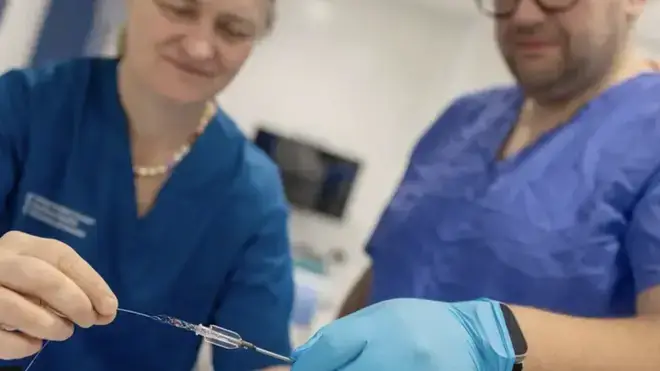The technology has been hailed as a potential "game changer" if it receives approval for use on patients
Doctors from Scotland and the US used the technology to remove blood clots on a human corpse following a stroke after the body was donated to medical science.
Prof Iris Grunwald from the University of Dundee was in control of the robot and conducted the operation from the Ninewells Hospital in Dundee.
Meanwhile, the body she was operating on using the technology was at a university facility.
Florida-based neurosurgeon Ricardo Hanel also used the technology hours later to perform the first transatlantic surgery from his Jacksonville base on a human body in Dundee over 4,000 miles (6,400km) away.
It has been hailed as a potential "game changer" if the technology receives approval for use on patients, with hopes it could solve delays for patients waiting to receive specialist stroke care.
"It felt as if we were witnessing the first glimpse of the future.
"Where previously this was thought to be science fiction, we demonstrated that every step of the procedure can already be done," Prof Grunwald said.
She added: "For example, here in Dundee we're covering the north of Scotland – so a patient coming from Inverness, or one of the islands, would have a long distance to travel.
"The answer lies in expanding expertise locally through cross-specialty training, or by using robotic technology, such as Sentante, that lets experts operate remotely."
The robot used by the expert was made by Lithuanian MedTech company Sentante.
It was hooked up to catheters and wires as the surgeon recreated the surgery using joysticks – while the robot performed identical movements in real time.
Edvardas Satkauskas, co-founder and CEO of Sentante, said: "The human cadaveric models at Dundee are fantastic. This is the reason we have worked with them – this is probably the only site in the world that can do this type of research.
"For an ischaemic stroke, the difference between walking out of hospital and a lifetime of disability can be just two to three hours. Today, patients are often transported long distances to reach one of a limited number of thrombectomy centres."
"With Sentante, the specialist comes to the patient over a secure network and performs the entire procedure remotely – with the same tactile feel and control they have at the bedside."
The team is hoping to be involved in clinical human trials next year.

